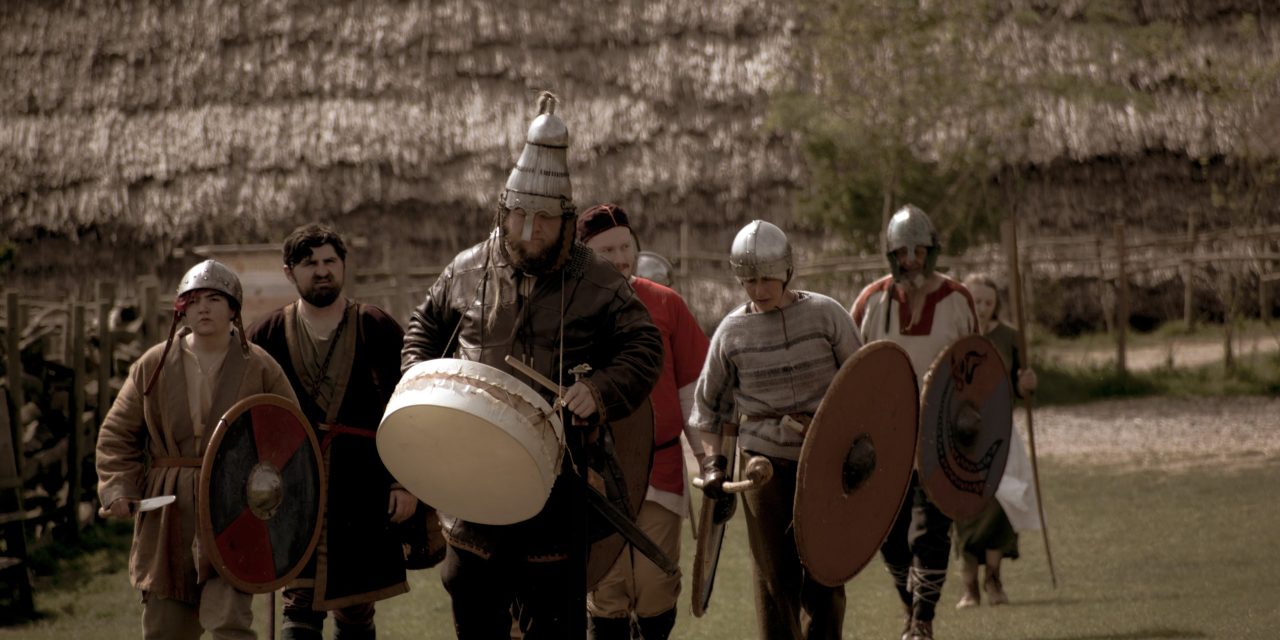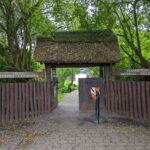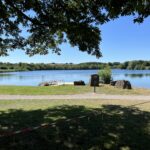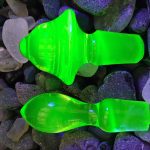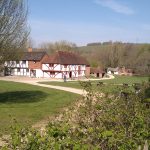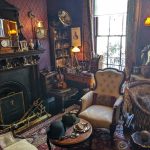What to expect from our article
Who is Herigeas Hundas?
Herigeas Hundas is a group of experienced historical battle reenactors based in Hampshire, England. Members are both men and women who depict the Anglo-Saxon period from the late 4th to the early 7th centuries. The group has a wealth of experience with cavalry and siege weapons, having carried out battle reenactments at various locations throughout the UK (including Butser Ancient Farm). Herigeas Hundas devotes a significant amount of time and effort to full-contact armed combat reenactment using a variety of weapons. This helps to create an immersive and entertaining experience for visitors.

Reenactments
Most of us have read about the terrifying battles that have taken place throughout history; how would you like to experience one firsthand? When confronted with an enemy’s archers, the Herigeas Hundas group can demonstrate a range of fighting techniques as well as the strength of a shield wall. A shield wall provides warriors with extra protection against any incoming weapons including flying arrows.

During a recent reenactment, we saw warriors successfully hold the shield wall while moving towards the enemy. At the last minute, they lowered their shields and launched an attack killing them all! ok, they didn’t really kill them all, it is just a reenactment after all. Battle reenactments are performed by highly skilled members of the Herigeas Hundas group (females included) giving you a first hand feel for what it would have been like on a real battlefield.

Living history
Herigeas Hundas don’t just stage battle reenactments, the group is composed of highly skilled craftsmen dedicated to preserving and promoting Saxon history. From blacksmiths, and woodworkers to leatherworkers and seamstresses, members are capable of reproducing items from the past using traditional Saxon methods and tools.

Herigeas Hundas Costumes
The costumes worn by Herigeas Hundas are as historically accurate as possible; in fact, it is stated on the clothing requirements list for new members that the stitching used on modern cloaks or blankets should be authentic and match the methods and materials that were used during Saxon times. The clothing can even be examined by an authenticity officer to ensure that it is a true representation of the period. They make every effort to ensure that only historically accurate materials like linen and wool are used, and those clothing items are represented in the correct colour by using natural dyes that were available at the time.
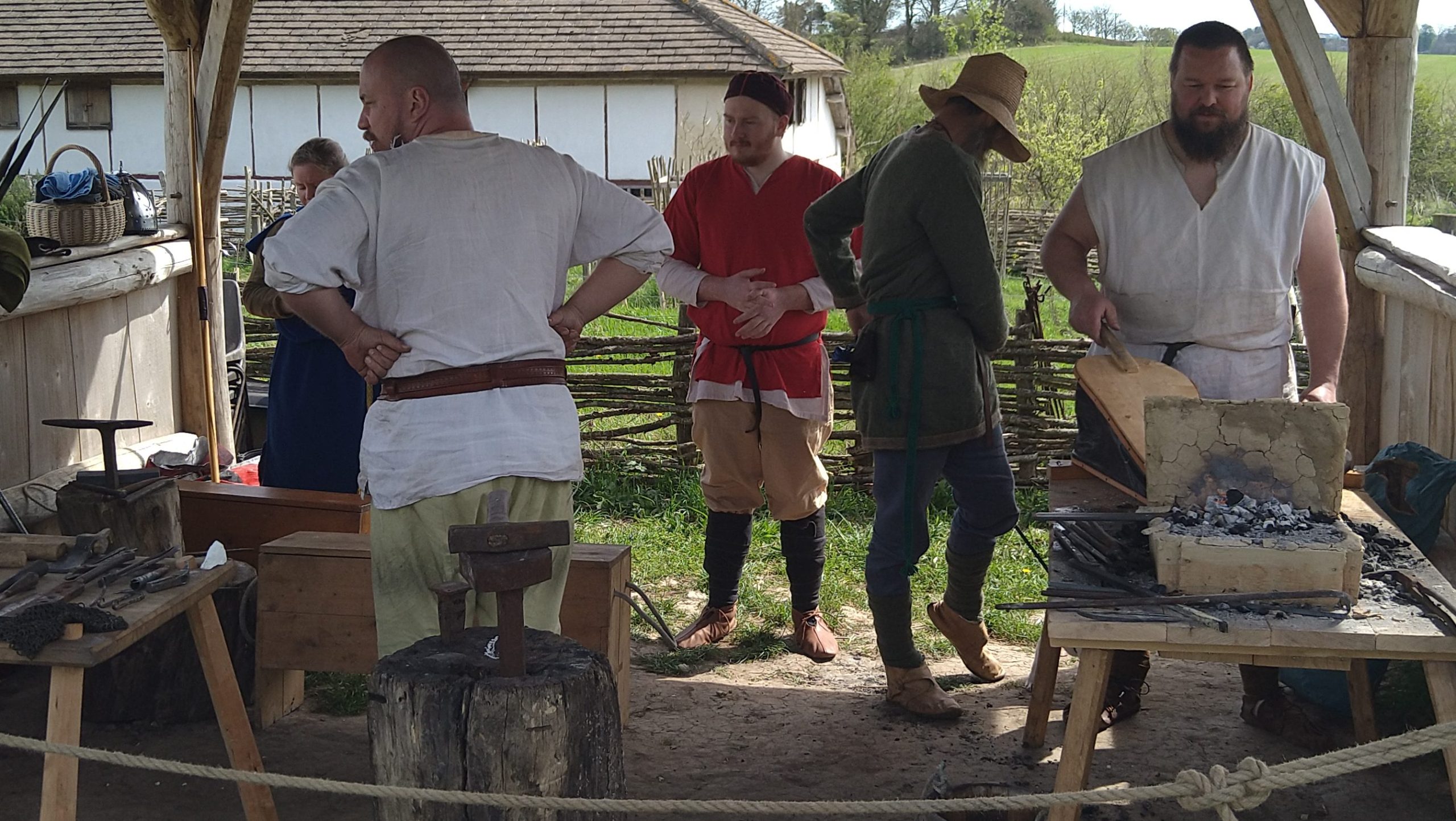
What were people wearing in Saxon times?
Saxon clothing worn by men
- Tunic – Tunic is made of wool or linen. It is typically knee-length, but it was occasionally worn at a shorter length and was belted at the waist. It was usually decorated at the wrists, neck and hem.
- Trousers – Trousers were woollen and held up by a belt.
- Leg bindings – Long strips of fabric wrapped around the legs, used to protect clothing and legs from bushes and biting insects. Leg bindings were also useful to keep the legs warm in cold weather.
- Belt – A leather belt is worn over the tunic from which they could hang tools such as knives and pouches
Saxon clothing worn by women
- Kirtle – A long sleeve linen dress which is worn underneath the outer dress and provides bust support and structure.
- Peplos – The dress is made from a large sheet of fabric that is folded over at the top and wrapped around the body. It is pinned at the shoulders to keep it from falling down.
- Belt – A belt would have been worn around the waist so they could attach things to it including knives, keys, amulets, and weaving tools.
Anglo Saxon England
The Roman army withdrew from Britain in the 5th century AD when the Anglo Saxons arrived. The Saxons were a group of settlers that included Angles and Jutes from Denmark, Saxons from Germany, Frisians from Holland, and Franks from Gaul. The Anglo Saxons came to southern Britain for a variety of reasons, including the desire to cultivate crops in more favourable conditions. There is also the possibility that they were invited by the locals to keep out Viking and Celt invaders from what is now known as Scotland and Ireland.

Anglo-Saxons were not Christian, but rather pagan in their beliefs and practices. They believed in several gods, rather than just one, and believed it was important to make offerings and sacrifices of food and animals to these gods to appease them. Anglo Saxons didn’t convert to Christianity until AD597.
Skilled Saxons
At the time of the Saxon invasion, only about one million people were living in England, and life would have been difficult under Saxon rule. Typically, the people of this period would have lived in small villages with around 100 people in each village, they would have lived in huts made of wood with thatched roofs with daub walls.

Saxon people would pretty much have been self-sufficient, growing crops and keeping animals such as Sheep, pigs, goats, horses and ox. Saxon people would have been highly skilled craftsmen making tools, clothing, furniture and weapons.

There were no schools back in Saxon times so children would have been taught a trade instead. Boys would be taught things like woodwork and blacksmithing and girls would be taught how to spin wool, make clothes and how to look after the home. I think it is quite sad that the trades of the past are being lost as the world becomes more modern and machinery is taking over.
Seamstress
The role of a seamstress was traditionally given to women; however, children could help with the beginning stages of the clothing manufacturing process, such as wool carding and wool spinning.

The duties of a seamstress would have included the production of yarn and fabric as well as making and repairing clothes. Dyeing yarn and fabric was accomplished using various plants, berries, lichens, and fungi.

The whole process of collecting, spinning and dyeing wool was very time consuming, so much so that one dress could take up to six months to complete. A seamstress would also have been skilled in tablet weaving and her skills would have been passed down from generation to generation.
Blacksmiths
Blacksmiths were the inventors and engineers of their time, designing and fabricating everything they needed, from farming equipment, and weaponry to cooking and eating utensils. Every Saxon village would have had a blacksmith hammering away creating essentials.

Leather
When it came to clothing and footwear, leather was one of the most widely used materials during this period, it was also used for a variety of other items such as bags, pouches, and water bags. Items such as knife and sword sheaths would have been embellished with elaborate designs.

Woodwork
Anglo Saxons were skilled woodworkers, they used wood to build their homes, tools, weapons and shields. wood was also used to make a variety of items, including boats, furniture and bowls. Making a wood worker an extremely valuable member of the community.

Medicine
The Anglo Saxon physician is also known as a leech and was typically a single individual, who could be either a man or a woman. They would have been skilled and knowledgeable in leechcraft – herbs and cures. Herbs were used in the preparation of several so-called cures during this time and medicine was administered in the form of tonics, poultices, and compresses. Leechcraft like all of the other skills from this period was passed down from generation to generation.

How do we know what life was like during the Saxon period?
Much of what we know about the early Anglo-Saxon period comes from archaeology, scientific research and manuscripts written by monks. This important information allows us to gain a better understanding of how difficult life was in early mediaeval Britain.
There is also a book written by a monk, named Venerable Bede, who lived in the fifth century. The ecclesiastical history of the English people is a valuable source of information about life in the early Anglo-Saxon period. The book tells us about terrible famines that struck England, as well as plagues that caused widespread disease and suffering.
Our experience of Herigeas Hundas
During the Easter holidays, we went to Butser Ancient Farm and saw the Herigeas Hundas for the first time. It was a fantastic experience and we were not disappointed. They put on an excellent battle reenactment and provided very informative talks to visitors. They were extremely friendly and eager to answer questions about what they were doing at the tents. They were also dressed in clothing from the Saxon period, which helped to bring the place to life. Herigeas Hundas was without a doubt my favourite part of our day at Buster Ancient Farm. I highly recommend you to attend one of their events.

Where can I see Herigeas Hundas?
You can see Herigeas Hundas performing at various locations throughout the UK during 2022 including;
- Winchester City Museum, Winchester
- Butser Ancient Farm, Chalton
- Sustainability Centre, Petersfield
- South of England Showground, Ardingly
- Stonham Barns, Stonham Aspal
- Kent County Showground, Kent
- Rockbourne Roman Villa, Fordingbridge
- Arundel Castle, Arundel
For more information and a full list of events and locations click here

